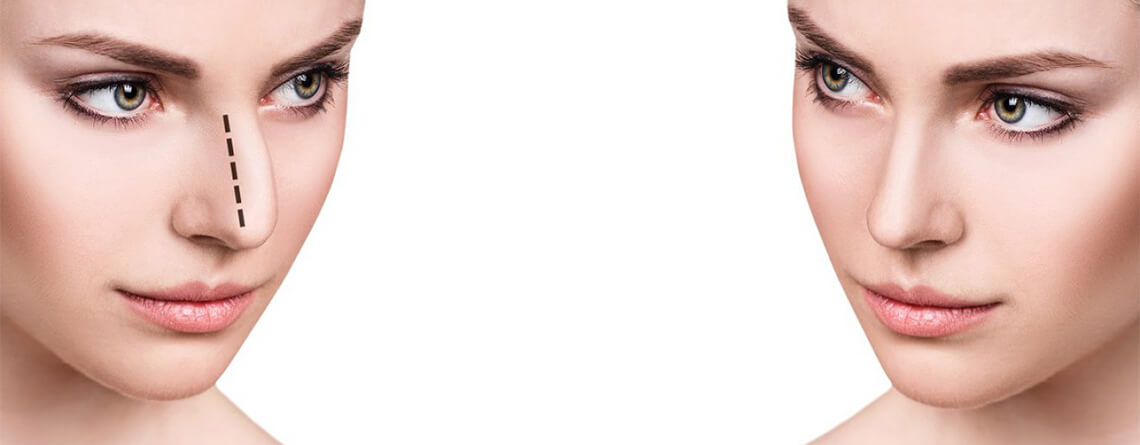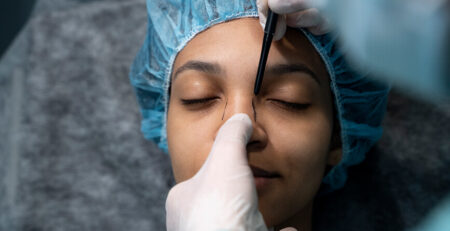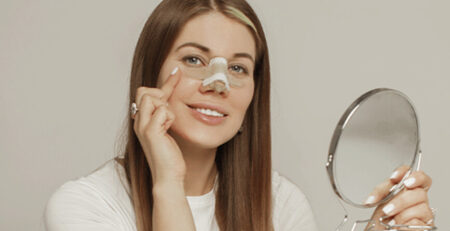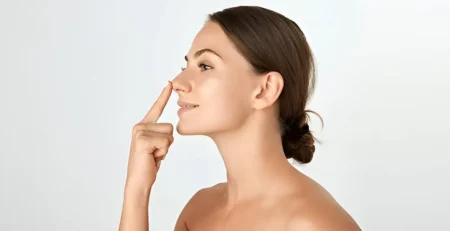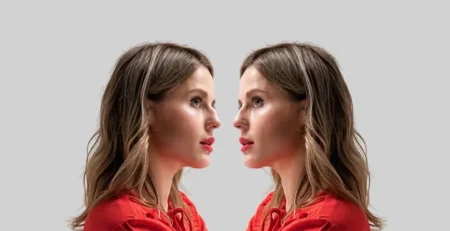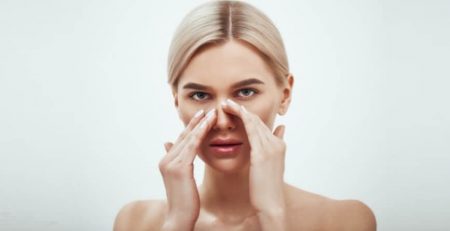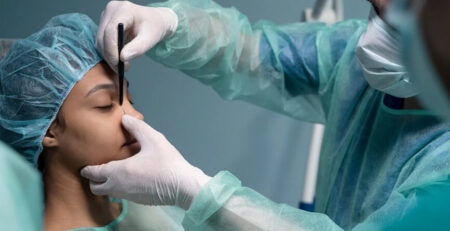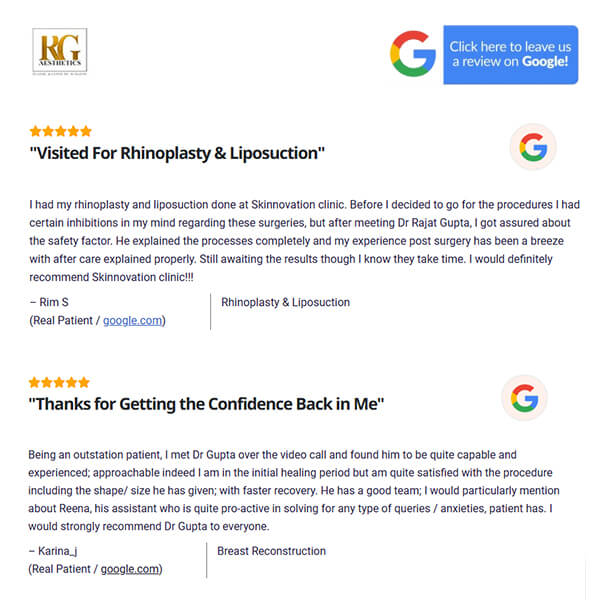Complete Guide to Rhinoplasty Surgery in India
Whether it’s less or more, a relatively small physical alteration to your nose may lead to significant improvements in your beauty by bringing your entire face into harmony.
If you’re contemplating getting a nose job medically known as Rhinoplasty surgery in India, this is the right blog for you!
The nose has a significant influence on the overall coherence of the face. The face might appear flat and wide if the nose is too tiny. The chin may seem less beautiful if the nose is excessively broad, and other features may be overshadowed. The objective of a nose job is to make the nose blend in with the rest of the face.
Rhinoplasty Surgery in India
Rhinoplasty is one of the most advanced cosmetic surgeries in the world today. The main purpose of this surgery is to reshape and resize the nose to fix breathing problems and to give an overall aesthetic appearance.
The rhinoplasty procedure improves the appearance of the nose as well as any functional issues. It’s a safe way to change the size of your nose in proportion to the rest of your face.
It can also alter the breadth of the bridge of the nose and minimise the sight of humps or severe depression on the nose. The Rhinoplasty procedure can correct the placement of the nasal tip, the size of the nostrils, and the symmetry of both nostrils.
Have questions or want to get started? We are ready to help you with a smile!
When to go for Rhinoplasty surgery in India?
A nose job can be done for aesthetic or reconstructive reasons. So let’s have a look at each factor of perspective one by one.
Rhinoplasty for Cosmetic Concern
The focus point of your face is your nose, eyes, and lips. They combine to form your identity and impact how others recognise you. You’ve probably heard folks talk about powerful noses and hard jaws? That’s because the nostrils and lips of these people have an effect as they remain in mind. Not only celebrities but many non-celebs people are opting for rhinoplasty surgery in India today.
This is a major thing that influences many people to get nose jobs. They just feel better about themselves as a result of it. It’s not for others, but only to feel better when they look in the mirror. Many actresses and models are also aware that their appearance is an important aspect of their work. As a result, if they are unsatisfied, they undergo a nose operation. They believe it increases their chances of landing a job.
Therefore, rhinoplasty is also performed for cosmetic purposes. They have also assured the nose of their goals if they choose a good surgeon with a steady hand and a thorough understanding of the operation. However, there could be a medical necessity for rhinoplasty in specific circumstances.
Rhinoplasty for Reconstructive Concerns
Nasal abnormalities are a common and sad occurrence. Some people are born with them, while others acquire them. Simply falling down and not having the ability to stop yourself can damage your nose. Your nose may shatter and deform if it falls to the ground.
There are five main ways to distort your nose and develop a nasal deformity. These are some of them:
Genetic Deformities: These are congenital defects such as a cleft palate, nasal mass, or structural weakness in the nose.
Crooked Septum: The septum is the cartilage wall that separates your nasal passages. It can deviate. It might be deformed or twisted to one side. This might be a congenital condition or the result of trauma. In any case, it frequently results in a variety of respiratory issues.
Saddle Nose: A saddle nose indicates that it is slanted or has a slightly curved bridge. This is frequently induced by trauma or disease. It can also be readily corrected by rhinoplasty.
Hooked Nose: As you become older, your nose becomes more and more impacted. As the sides of the nose compress inward, this process can create drooping and blockage. Because of the absence of support, the nose may droop forward and seem hooked.
Dorsal Hump: The dorsal hump is the ultimate and most prevalent type of nose deformity. When you have a bump on your nose, this is what it means. This hump, which is usually caused by trauma, alters the look of your nose from every aspect. Rhinoplasty helps to balance out your nose and eliminates the hump.
A nose job is an effective treatment for each of these abnormalities. It seamlessly resolves any issue, making it appear as though the issue never happened.
Is Rhinoplasty surgery in India painful?
The best part is that rhinoplasty surgery is a relatively pain-free surgery. The only time you feel pain is when the anaesthesia is injected. When a needle punctures your skin, it creates discomfort. However, the anaesthesia is usually long-lasting to make a recovery considerably easier.
You have the option of having general or local anaesthesia. Your surgeon will choose the one that is most beneficial to you. These are the finest painkillers in surgery due to years of expertise and extensive development. You will be entirely safe if you follow the rules for selecting the correct surgeon, and your procedure should be completely painless and simple.
Before we talk about the operation, it’s important to grasp the distinction between rhinoplasty and septoplasty.
How is the rhinoplasty procedure different from a septoplasty procedure?
As previously stated, a deviated septum is one of the most common nasal abnormalities. When the septum is crooked or shifted to one side, this is known as a deviated septum. This frequently results in breathing difficulties, snoring, and a dry mouth.
A septoplasty is a procedure that corrects a deviated septum. It does not, however, affect the form of the nose. Assume a patient has a deviated septum as well as a saddle nose. Only the septum would be fixed by the septoplasty. A rhinoplasty would be required to correct their saddle nose. For this reason, rhinoplasty frequently includes septoplasty.
Rhinoseptoplasty is the name given to the operation as a whole. It can be used for both aesthetic and reconstructive or medicinal objectives.
Before looking at how rhinoplasty affects different portions of the nose, we need to know what they are.
The four divisions of the nose are the bone, which is located near the top of the nose near the forehead; the upper cartilage, which extends until the tip; the lower cartilage, which is located at the tip and around the nostrils; and the skin, which encompasses everything and connects the nostrils.
There are other types of cartilages as well. The central cartilage, known as the septal cartilage, deviates, resulting in a deviated septum. On either side of the nose, there are the upper and lower lateral cartilages.
Finally, the major and minor alar cartilages, the latter of which forms the nose’s base, are present. Let’s talk about the procedures now that we’ve gotten a handle on the numerous terminologies involved with rhinoseptoplasty.
How is Rhinoplasty performed?
The surgeon will either use general or local anaesthesia, depending on their choice and what they feel would produce the greatest outcomes.
They then make three incisions: one within each nostril, one at the base of the nose, and one at the tip of the nose. They can then raise your skin as a cover, revealing the underlying structure. The adjustments are then made based on the patient’s wishes. The incisions are closed with absorbable sutures, so the patient does not need to return to the physician to have them removed. Rhinoplasty help with different types of nasal deformities.
Broad Nose Deformity
If the patient wants a thinner nose, the nasal bones are broken and reshaped. This makes it easier for them to work together. The operation is known as osteotomy, and it is commonly employed on a variety of bones across the body.
Your surgeon may resect or chop off portions of the alar cartilages if the patient has a large nasal base. After that, they’re placed together for the new width.
Dorsal Hump Deformity
When a patient has a dorsal hump, another technique includes correcting the nasal bones. This is when the Piezotome comes into play. The Piezotome rasps the bone, thereby smoothing out the hump and creating a straight centre line.
Using the Piezotome also assures that no other tissues are harmed save the bone. Sometimes there is cartilage in the hump. In such circumstances, the surgeon resects the cartilage to keep the central alignment in such circumstances.
Saddle Nose Deformity
The surgeon uses a dorsal craft material to correct a sunken or saddle nose. This is placed in the depression on the dorsum. A dorsum craft can be made from cartilage extracted from the septum or ribs, or it can be made from an implant.
Hooked Nose Deformity
The tip of the lower lateral cartilages is turned upwards using a technique known as cephalic dissection. This improves the appearance and eliminates the drooping appearance.
As a result of these methods, the entire experience is positive. For example, you may remove a dorsal hump and make your base thinner for a more pleasing final appearance.
Such techniques assure the patient’s maximal satisfaction, which is, at the end of the day, the surgeon’s ultimate purpose. As previously stated, these surgeries can be coupled with a septoplasty to create a rhinoseptoplasty for the best outcomes.
How is Septoplasty performed?
When the septum deviates into a C or S form, it obstructs regular breathing and necessitates a septoplasty. A septoplasty straightens the septum by removing a small amount of cartilage from the centre.
The greatest results are obtained by combining these approaches. Furthermore, the advent of ultrasonic technology has resulted in greater results with far less trauma. It makes the recovery process much more pleasant.
How long does it take to recover from rhinoplasty surgery in India?
The treatment is a daycare surgery, which indicates the patient will be able to resume their normal activities the next day.
A splint or plaster is applied to the patient’s nose after surgery. For 24 to 48 hours, the nasal orifices are closed and stuffed with paraffin gauze. The patient must wear a mask on their top lip that must be changed many times a day. Patients may have a little bleeding, which may be treated with a damp cotton swab placed on the nose until it stops flowing.
The splint is discarded after 7-9 days. The bruising and swelling go away over the next few days, and the nose softens with time.
Patients can begin modest sports after 15 days, although it is advised that heavier workouts be resumed after a month and consultation with your surgeon.
People throughout the globe benefit from rhinoplasty procedure in this way. The only stumbling block to obtaining a nose operation is your age. Generally, surgeons only do nose jobs on female patients above the age of 15. The age restriction for guys is significantly greater because their noses mature at a later age.
However, irrespective of when the patient has their nose job, they are overjoyed with the results. They have never felt so good about themselves, and their self-esteem has risen.
Dr Rajat Gupta, the board-certified experienced plastic surgeon in Delhi, has mastered the nose operation to bring such joy. He excels in ultrasonic rhinoplasty using the state-of-the-art Piezotome equipment at his disposal, delivering high-quality, remarkable outcomes for all of his patients. We agree with him that the patient and their demands should always come first to get the most attractive and natural-looking outcomes from their rhinoplasty surgery in Delhi!
Dr. Rajat Gupta
MBBS, MS, DNB(Gen. Surg.),
DNB (Plastic Surgery)
Dr. Rajat Gupta is a board certified plastic surgeon in India with 13 years of experience to back his expertise in the domain of aesthetic surgeries.
Having completed his training from Maulana Azad Medical College and equipped with a thorough understanding of aesthetic needs of people, Dr. Gupta strives to offer the best remedies and cosmetic procedures outfitted with the latest technology to the aspirants in India and across the globe. To book an appointment, call: +91-9251711711 or email: contact@drrajatgupta.com

